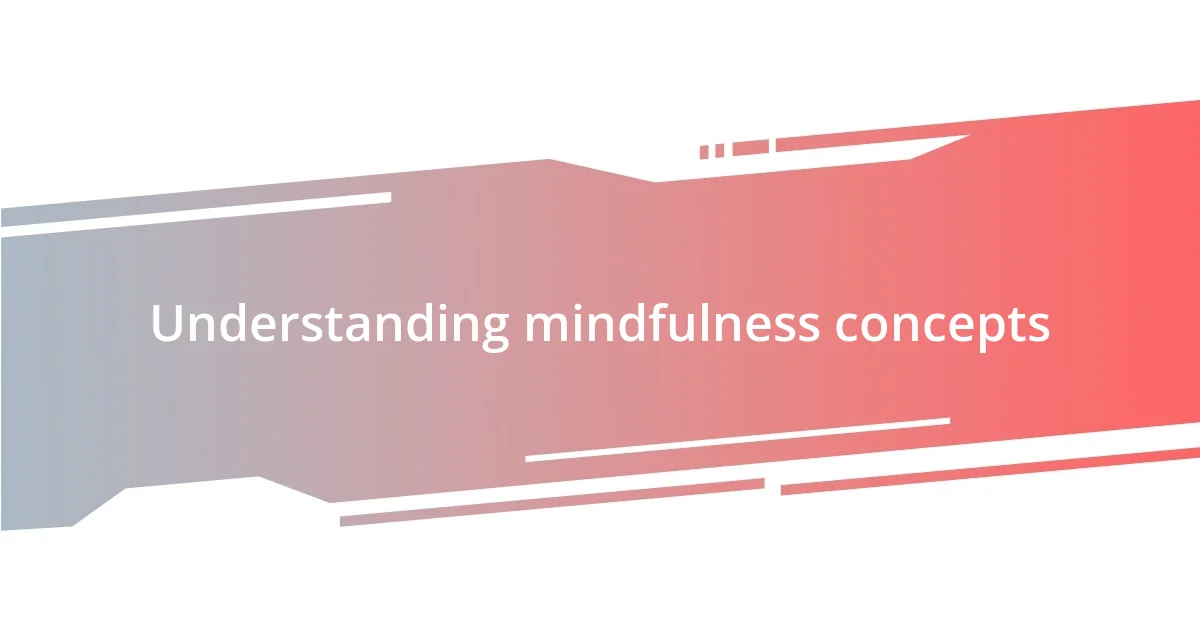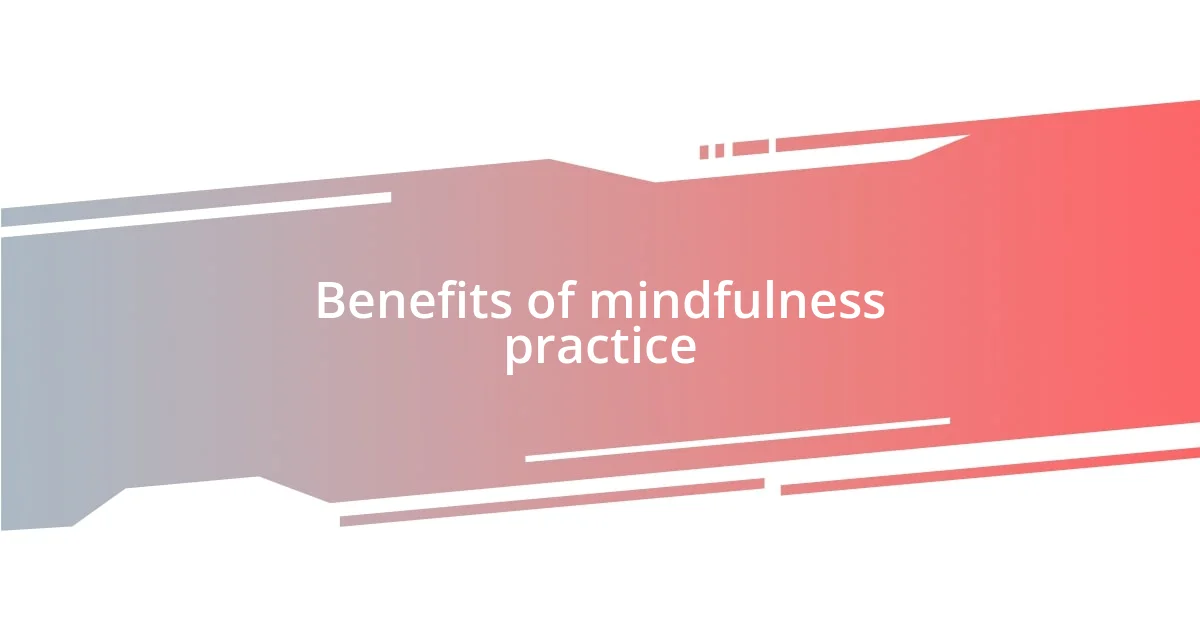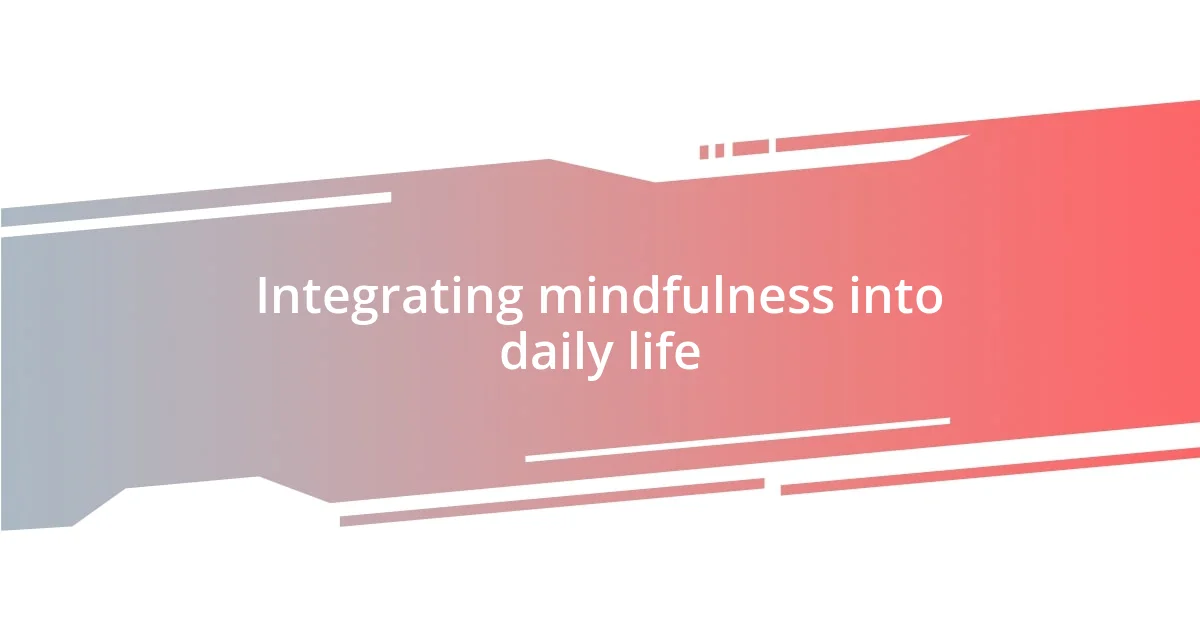Key takeaways:
- Mindfulness emphasizes acceptance and non-striving, allowing individuals to embrace their emotions and let go of the pressure to be perfect.
- Practicing mindfulness enhances stress management, emotional resilience, and relationship depth through improved awareness and connection.
- Incorporating techniques like mindful breathing, body scanning, and mindful eating into daily routines transforms ordinary moments into opportunities for presence and connection.

Understanding mindfulness concepts
Mindfulness is often described as the practice of being present, but for me, it’s more about embracing the here and now without judgment. I vividly recall a moment during a quiet afternoon walk when I noticed the vibrant colors of the leaves, each one a reminder that being fully aware can transform the mundane into the extraordinary. Have you ever just paused to appreciate a moment, feeling the world around you as if you were experiencing it for the first time?
One of the core concepts of mindfulness is acceptance. This idea resonated deeply with me during a challenging period in my life. I learned that fighting against my feelings only intensified my struggles. Instead, by accepting my emotions, both the joy and the pain, I could allow myself to heal. Isn’t it fascinating how simply acknowledging our thoughts can shift our perspective?
Another concept that I find invaluable is non-striving. This can be a tough pill to swallow in today’s fast-paced world. I remember trying to meditate and feeling frustrated at how difficult it was to simply “be.” However, I began to realize that the practice isn’t about achieving a calm mind but about allowing thoughts to come and go freely. How freeing is it to let go of the pressure to be perfect, don’t you think?

Benefits of mindfulness practice
Mindfulness practices offer a plethora of benefits that can significantly enhance our daily lives. For me, one of the most profound advantages is an increased ability to manage stress. I remember a particularly hectic week at work when I felt overwhelmed by deadlines. By taking a few moments each day to practice mindfulness, I was able to step back and center myself. It was remarkable how those short breaks transformed my mindset, helping me approach each task with a clearer head and a calmer heart.
On a more personal note, mindfulness has greatly improved my emotional resilience. During a period when I faced personal challenges, I found that regularly practicing mindfulness equipped me with tools to navigate difficult emotions. Instead of spiraling into negativity, I allowed myself to feel my emotions without judgment. I discovered that embracing my feelings—whether good or bad—helped me grow stronger and more compassionate toward myself. Isn’t it incredible how being aware of our emotional landscape can empower us to face life’s ups and downs with grace?
Finally, I’ve noticed that mindfulness enhances my overall well-being by promoting a sense of connection. Engaging with the world more mindfully has deepened my relationships. I remember a conversation with a friend where I put my phone away and truly listened to her. The connection we shared during that moment was priceless and led to a more meaningful dialogue about our lives. How can something as simple as focused attention bring us closer to those we care about?
| Benefit | Description |
|---|---|
| Stress Management | Mindfulness helps reduce stress, allowing for clearer thinking and calmer reactions. |
| Emotional Resilience | It builds emotional strength by encouraging acceptance of all feelings without judgment. |
| Enhanced Relationships | Mindfulness fosters deeper connections through improved listening and presence. |

Techniques for effective mindfulness
What I’ve found most effective in my mindfulness journey are specific techniques that help anchor my awareness in the present moment. For instance, I often practice mindful breathing, meticulously focusing on each inhale and exhale. During a particularly stressful day, this breathing exercise offered me a slice of peace; it was astonishing how just a few deep breaths could reset my entire outlook.
Here are some techniques that can enhance your mindfulness practice:
- Body Scanning: I lie down and mentally scan my body, noticing each part, from my toes to my head. This technique helps me release tension and fosters a deeper connection to my physical self.
- Mindful Walking: Taking a stroll while paying attention to my steps and surroundings allows me to anchor myself in the moment. I often feel like a child, rediscovering the joy in each rustle of leaves.
- Gratitude Journaling: Each evening, I jot down three things I’m grateful for, which shifts my focus to the positive aspects of my day. It has a remarkable way of brightening my mood before sleep.
- Engaging Senses: When preparing a meal, I focus intently on the smell of the ingredients and the textures as I chop. This practice transforms a routine task into a delightful sensory experience.
By incorporating these techniques, I’ve discovered that mindfulness isn’t just a practice; it often shapes my entire day. Each moment becomes an opportunity for awareness and connection, which I cherish deeply.

Integrating mindfulness into daily life
Integrating mindfulness into my daily life has been a real game-changer. For example, I try to practice mindfulness while brushing my teeth. I focus on the motion of the brush, the taste of the toothpaste, and even the sound of the bristles. It might sound trivial, but this simple act grounds me and sets a calm tone for the day ahead. Have you ever thought about how a daily routine can become a moment of mindfulness?
One technique that resonates with me is mindful eating. I’ve made a habit of putting away distractions during meals, allowing myself to truly savor each bite. I remember a dinner where I paid close attention to the flavors and textures of my food, relishing the warmth and scent wafting up from my plate. It transformed a mundane task into a delightful experience. I find myself wondering: how often do we rush through meals and miss the joy of the moment?
Finally, I make a conscious effort to incorporate mini mindfulness breaks throughout my day. Whether it’s pausing between meetings to take a few breaths or stepping outside for a moment of fresh air, these breaks have become essential for re-centering myself. There was one afternoon when I felt particularly drained, and just a five-minute break to focus on my surroundings rejuvenated my spirit. Have you ever taken a moment to just breathe and felt the difference it makes? These small integrations truly add up, creating a tapestry of mindfulness woven through my daily life.

Mindfulness exercises for stress relief
Mindfulness exercises for stress relief
When I first tried progressive muscle relaxation, I was surprised by how effective it was in alleviating stress. I started by tensing and then relaxing each muscle group one by one, beginning with my toes and gradually working my way up to my head. It felt like letting go of heavy weights I didn’t even know I was carrying; I always wonder if others might find that same relief through such simple practices.
Guided imagery is another powerful technique I have embraced. I often close my eyes, and envision a serene place—perhaps a quiet beach or a peaceful forest. As I immerse myself in this imagined escape, I can almost hear the gentle waves and feel the soft breeze across my skin. It’s fascinating how such vivid mental images can transport me away from daily stresses, creating a moment of calm in the chaos.
One technique that has consistently helped me is the use of a mindfulness app for brief meditations. I remember a particularly tough week when anxiety felt like a constant companion. Dedicating just ten minutes each day to follow guided sessions became my anchor; those few minutes gave me clarity amid uncertainty. Have you ever tried setting aside time just for yourself in the midst of a busy schedule? That little commitment can lead to significant peace of mind.

Overcoming challenges in mindfulness
It’s not uncommon to encounter roadblocks on the mindfulness journey. For me, distractions often arise at the most inopportune times, like when I’m trying to focus on my breath during meditation. One morning, I found my mind racing with thoughts about the day ahead, and I realized that allowing those distractions to linger only made it harder to settle into the moment. Have you ever noticed how challenging it can be to quiet those inner voices?
Embracing discomfort has been another hurdle. There are sessions when my body feels restless, and I have to remind myself that it’s okay to experience discomfort rather than fight it. I recall a meditation during a particularly tough week where I simply sat through the itchiness and urges to move. It wasn’t easy, but that acceptance allowed me to cultivate a deeper sense of resilience. Isn’t it interesting how sitting with discomfort can sometimes open up pathways to greater awareness?
Lastly, there are days when I question the effectiveness of my practice. I sometimes wonder if I truly notice a difference in my mood or focus. Reflecting on those moments has led me to realize that mindfulness isn’t always about the immediate benefits; rather, it’s a gradual process of growth. I often think back to how I felt after just a week of consistent practice—it was subtle yet profound. Have you ever found yourself in a similar space, doubting your efforts, only to look back and appreciate the small milestones along the way?

Personal experiences with mindfulness practice
My initial foray into mindfulness was a bit clumsy, yet transformative. I vividly remember sitting on my living room floor for the first time, attempting to practice mindful breathing. I thought I could just focus my thoughts, but they were all over the place—next thing I knew, I was crafting elaborate grocery lists in my head instead of staying present. It surprised me how challenging it was to simply be, but that realization sparked a genuine curiosity within me.
One instance that sticks with me is when I decided to incorporate mindful walking into my routine. On a crisp autumn afternoon, I took a stroll in the park, paying full attention to each step. I focused on the crunch of leaves underfoot and the cool breeze brushing against my face. It felt like a mini-vacation, enriching my connection to the world around me. Have you ever experienced that kind of presence in an otherwise mundane activity? It’s remarkable how such simple acts can deepen our appreciation of life.
I also recall a meditation session where emotions bubbled up unexpectedly. As I sat in silence, thoughts of a recent family conflict nudged at my heart. Instead of pushing those feelings away, I allowed myself to sit in the discomfort, exploring the anxiety that crept in. It became somewhat of a release, and I wondered if others might find that confronting their feelings could be equally enlightening. Isn’t it intriguing how mindfulness can turn painful moments into opportunities for healing?















